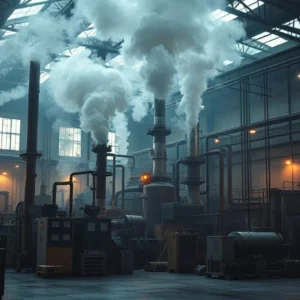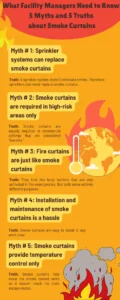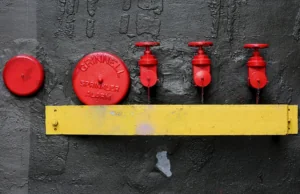American Made, Iron Clad Protected - Discover the Industries Best Warranty.
Blog
5 Myths and 5 Truths about Smoke Curtains
What Facility Managers Need to Know: 5 Myths and 5 Truths about Smoke Curtains
When it comes to achieving industrial fire safety, we often give a higher priority to controlling flames. However, controlling smoke is as crucial as getting rid of the fire. Firefighters can only control the fire if the environment isn’t surrounded by smoke. Excessive smoke makes it difficult for firefighters to see through the surroundings and get immediate control over the fire. That’s why it makes sense to use smoke curtains or draft curtains.
Besides having adequate fire safety equipment, it’s crucial to have smoke curtains in industrial settings to suppress the spread of smoke in emergency situations effectively. That’s why most business owners make extra efforts to install the best smoke curtains and draft curtains for their workspaces. But some facility managers and safety engineers often underestimate the role of managing smoke. That’s due to some common misconceptions about smoke curtains.
Having clarity about smoke curtains and draft curtains is especially important for those managing warehouses, manufacturing plants, distribution centers, and other facilities that carry a risk of catching fire.
In this blog post, we’ll uncover the five myths and five truths about smoke curtains so you can make an informed and safe decision before considering these special curtains.
Myth # 1: Sprinkler systems can replace smoke curtains
A lot of facility managers might believe that smoke curtains aren’t a necessity if they already have installed sprinkler systems in their buildings.
Truth:
Sprinklers are helpful in controlling flames as the water douses the fire. But a sprinkler system doesn’t eliminate smoke. Since smoke can travel faster than flames, it leads to immediate suffocation, breathing issues, and reduced visibility among those present during the fire incident.
Smoke inhalation is also the real cause behind 60% to 80% of deaths, according to a study. Therefore, sprinklers can never replace smoke curtains.
Designed to limit smoke to a specific area or work zone, smoke curtains help slow the movement and progression of smoke. This increases the productivity of smoke extraction systems while also clearing evacuation routes. So, both sprinkler systems and smoke curtains have their own roles to play.
What to do: You should have both of these fire prevention assets operating in your facility.
Myth # 2: Smoke curtains are required in high-risk areas only
Many believe that smoke curtains are required only in industrial spaces that are at a higher risk for catching sparks such as welding areas, construction sites, and electronics factories.
Truth:
Smoke and fire can cause severe destructions anywhere. It indicates that the risk is equally present in any commercial location. Those managing data centers, warehouses, healthcare centers, hospitals, airports, and factories ensure that they install smoke curtains to avoid any unfavorable incident. But little do we know that they are equally required in commercial settings that are considered “low-risk.” In reality, smoke tends to spread rapidly even in low-risk, open, or large spaces including shopping malls, parking spaces, office buildings, educational centers, restaurants, hotels, and gyms.
Even the materials inside low-risk areas (such as papers, plastics, electronics, and fabrics) can catch a spark of fire. This can generate rapid smoke in a matter of seconds – thus, leading to severe destruction.
What to do: It’s wise to devise a smoke control strategy for both high-risk areas and low-risk areas.
Myth # 3: Fire curtains are just like smoke curtains
Various architects, facility managers, and building owners mistakenly assume that fire curtains and smoke curtains are interchangeable. Among both options, they choose one.
Truth:
Both these curtains have a similarity: they look like large barriers that are only activated in fire emergencies. But both serve entirely different purposes.
Smoke curtains or draft curtains contain and control smoke in a way that it doesn’t travel to escape routes (including lobbies, stairwells, and atriums). Instead, these curtains direct the smoke to ventilation systems so that the escape routes are clear and visible. The absence of smoke in these escape routes also helps everyone exit the affected area safely without getting into a panic situation.
On the other hand, fire curtains block flames and heat while preventing fire from spreading further to other work zones or areas. However, these curtains aren’t designed to block smoke.
What to do: You should add both smoke curtains as well as fire curtains to your fire safety plan.
Myth # 4: Installation and maintenance of smoke curtains is a hassle
Some believe that smoke curtains are complex and might require structural changes. Many also think that the maintenance can be burdensome.
Truth:
Smoke safety in industrial settings is evolving day by day. This is one of the reasons why smoke curtain manufacturers are offering pre-engineered smoke curtains that have a lightweight design. This feature makes them easy to install in any work zone. The drop length and width aren’t a concern while installing these smoke safety measures.
Since smoke curtains and draft curtains are customizable, they are a practical option for buildings that have high ceilings. Routine maintenance is a wise option. It requires basic inspection for electrical functionality, alignment, and wear-and-tear. If done regularly, maintenance of these curtains isn’t time-consuming.
What to do: Read installation guidelines to ensure smooth and error-free installation. Also, you can stay proactive by devising a monthly smoke curtain maintenance plan.
Myth # 5: Smoke curtains provide temperature control only
This misconception makes people believe that smoke curtains preserve heat when a fire incident strikes. They aren’t aware that these curtains enable breathable air to reach the escape routes.
Truth:
Draft curtains function differently because they serve a broader purpose. Even before the flames harm occupants, it’s the toxic smoke that can be life-threatening to them. By operating alongside extraction systems, these curtains help move the smoke toward vents so it doesn’t reach the main escape routes. Besides, they help withstand heat but also act as life savers by limiting smoke migration. Therefore, both smoke reduction and temperature control should be the top priority while devising the fire elimination strategy for any industrial business.
What to do: Think of smoke curtains as providing more benefits than just HVAC efficiency. Installing both smoke curtains and HVAC systems in a commercial space can be worthwhile to achieve fire safety.
The Takeaway
During a fire outbreak, uncontrolled smoke can have life-threatening consequences at any commercial site where workers, supervisors, facility managers, and other stakeholders are presently working. That’s why removing any misunderstandings about smoke curtains and draft curtains is essential.
Now that you are aware of the myths and truths about smoke curtains, you can easily take a proactive approach towards choosing and installing NFPA-complaint smoke curtains for your facility. However, what matters is to make a smart decision before any mishap strikes. That’s why all facility managers or business owners should ask the manufacturer if they fulfill NFPA 92 requirements and other fire safety standards.
To provide maximum protection to your facility, you should evaluate your fire protection systems regularly, choose high-quality smoke curtains, and maintain them according to the manufacturer’s instructions.
Recent Posts
- Softwall vs Hardwall Insulation Barriers: Pros, Cons, and ROI Breakdown
- ‘Clean Zone’ or ‘Cross-Contamination Nightmare’? How to Tell If Your Warehouse Passes the Test
- The Silent Safety Hero: Why Fixed Draft Curtains Are Required in High-Rack Storage Facilities
- The Invisible Risk: How Contamination Happens Without Proper Warehouse Barriers
- Are Your Insulated Warehouse Curtains Compliant
- Understanding Noise Regulations – When Is a Temporary Noise Barrier Legally Required?
- 7 Powerful Ways Industrial Curtain Walls Boost Employee Productivity
- Noise Enclosures vs. Traditional Soundproofing: Which Is Right for Your Facility?
- Steel Guard Safety Achieves SBA HUBZone Certification, Expanding Government Market Opportunities
- 5 Myths and 5 Truths about Smoke Curtains
Categories
- Accordion Fold Curtains
- Acoustic Baffles
- Agri-Shield Curtains
- Auto Body Shop Curtains
- Bio Plastics
- Draft & Smoke Curtains
- Industrial Divider Curtains
- Industrial Safety Products
- Insulated Curtain Walls
- Machine Guard Safety Fencing
- Mesh Curtain Screens
- News
- Outdoor Curtains
- PVC Strip Curtains
- Smoke & Draft Curtains
- Soundproof Noise Blocking Curtains
- Spray Paint Booth Curtains
- Tarps
- Thermal Curtains & Covers
- Uncategorized
- USDA Wash Down Curtain
- Warehouse Dividers
- Welding Blankets
- Welding Curtains
- Welding Screens





